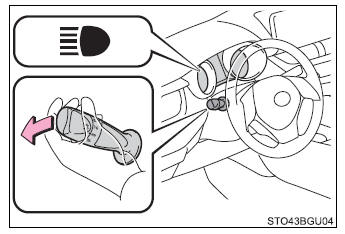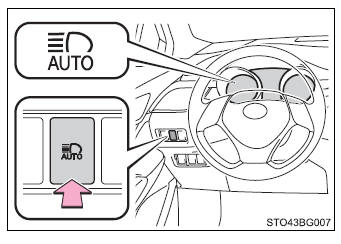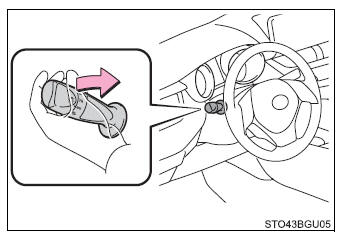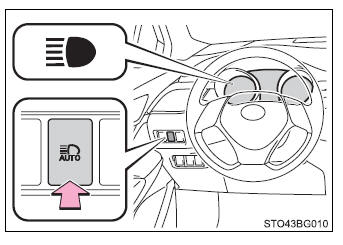Toyota CH-R Owners Manual: Automatic High Beam
The Automatic High Beam uses an in-vehicle camera sensor to assess the brightness of streetlights, the lights of vehicles ahead etc., and automatically turns the high beam on or off as necessary.
■Limitations of the Automatic High Beam Do not rely on the Automatic High Beam. Always drive safely, taking care to observe your surroundings and turning the high beam on or off manually if necessary.
■To prevent incorrect operation of the Automatic High Beam system Do not overload the vehicle.
Activating the Automatic High Beam system
1. Push the lever away from you with the headlight switch in the or
or
 position.
position.

2. Press the Automatic High Beam switch.
The Automatic High Beam indicator will come on when the headlights are turned on automatically to indicate that the system is active.

Turning the high beam on/off manually
■ Switching to low beam Pull the lever to the original position.
The Automatic High Beam indicator will turn off.
Push the lever away from you to activate the Automatic High Beam system again.

■ Switching to high beam Press the Automatic High Beam switch.
The Automatic High Beam indicator will turn off and the high beam indicator will turn on.
Press the switch to activate the Automatic High Beam system again.

■High beam automatic turning on or off conditions
- When all of the following conditions are fulfilled, the high beam will be
automatically turned on (after approximately 1 second):
- Vehicle speed is above approximately 21 mph (34 km/h).
- The area ahead of the vehicle is dark.
- There are no vehicles ahead with headlights or tail lights turned on.
- There are few streetlights on the road ahead.
- If any of the following conditions are fulfilled, the high beam will be
automatically turned off:
- Vehicle speed drops below approximately 17 mph (27 km/h).
- The area ahead of the vehicle is not dark.
- Vehicles ahead have headlights or tail lights turned on.
- There are many streetlights on the road ahead.
■Camera sensor detection information
- The high beam may not be automatically turned off in the following situations:
- When oncoming vehicles suddenly appear from a curve
- When the vehicle is cut off in front of by another vehicle
- When vehicles ahead are hidden from sight due to repeated curves, road dividers or roadside trees
- When vehicles ahead appear from the faraway lane on wide road
- When vehicles ahead have no lights
- The high beam may be turned off if a vehicle ahead that is using fog lights without using the headlights is detected.
- House lights, street lights, traffic signals, and illuminated billboards or signs may cause the high beam to switch to the low beams, or the low beams to remain on.
- The following factors may affect the amount of time taken to turn the high
beam on or off:
- The brightness of headlights, fog lights, and tail lights of vehicles ahead
- The movement and direction of vehicles ahead
- When a vehicle ahead only has operational lights on one side
- When a vehicle ahead is a two-wheeled vehicle
- The condition of the road (gradient, curve, condition of the road surface, etc.)
- The number of passengers and amount of luggage
- The high beam may be turned on or off when the driver does not expect it.
- Bicycles or similar objects may not be detected.
- In the situations shown below, the system may not be able to accurately
detect surrounding brightness levels. This may cause the low beams to remain
on or the high beams to cause problems for pedestrians, vehicles ahead or other
parties. In these cases, manually switch between the high and low beams.
- In bad weather (rain, snow, fog, sandstorms, etc.)
- The windshield is obscured by fog, mist, ice, dirt, etc.
- The windshield is cracked or damaged.
- The camera sensor is deformed or dirty.
- The camera sensor temperature is extremely high.
- Surrounding brightness levels are equal to those of headlights, tail lights or fog lights.
- Vehicles ahead have headlights that are either switched off, dirty, are changing color, or are not aimed properly.
- When driving through an area of intermittently changing brightness and darkness.
- When frequently and repeatedly driving ascending/descending roads, or roads with rough, bumpy or uneven surfaces (such as stone-paved roads, gravel tracks, etc.).
- When frequently and repeatedly taking curves or driving on a winding road.
- There is a highly reflective object ahead of the vehicle, such as a sign or a mirror.
- The back of a vehicle ahead is highly reflective, such as a container on a truck.
- The vehicle's headlights are damaged or dirty.
- The vehicle is listing or tilting, due to a flat tire, a trailer being towed etc.
- The high beam and low beam are repeatedly being switched between in an abnormal manner.
- The driver believes that the high beam may be causing problems or distress to other drivers or pedestrians nearby.
■Temporarily lowering sensor sensitivity The sensitivity of the sensor can be temporarily lowered.
1. Turn the engine switch off while the following conditions are met.
- The headlight switch is in
 or
or
 .
. - The headlight switch lever is in high beam position.
- Automatic High Beam switch is on.
2. Turn the engine switch to ON mode.
3. Within 30 seconds after 2, repeat pulling the headlight switch lever to the original position then pushing it to the high beam position quickly 10 times, then leave the lever in high beam position.
4. If the sensitivity is changed, the Automatic High Beam indicator is turn on and off 3 times.
Automatic High Beam (headlights) may turn on even the vehicle is stopped.
■If "Headlight System Malfunction. Visit Your Dealer." is displayed on the multi-information display The system may be malfunctioning. Have the vehicle inspected by your Toyota dealer.
 Headlight switch
Headlight switch
The headlights can be operated manually or automatically.
Operating instructions
Turning the
switch
turns on the lights as follows:
For U.S.A.
The headlights, side marker, parking ...
 Windshield wipers and washer
Windshield wipers and washer
Operating the wiper lever
Operate
lever as follows to select the wiper operation.
Intermittent windshield wipers with interval adjuster
When intermittent windshield wiper operation is selected, t ...
Other materials:
Toyota CH-R Service Manual > Heating / Air Conditioning: Blower Resistor
Components
COMPONENTS
ILLUSTRATION
*A
for Single Type
-
-
*1
BLOWER RESISTOR
*2
NO. 2 INSTRUMENT PANEL UNDER COVER SUB-ASSEMBLY
ILLUSTRATION
*A
for Dual Type
...
Toyota CH-R Service Manual > Front Suspension Member: Components
COMPONENTS
ILLUSTRATION
*1
NO. 1 ENGINE UNDER COVER
*2
REAR ENGINE UNDER COVER LH
*3
REAR ENGINE UNDER COVER RH
-
-
N*m (kgf*cm, ft.*lbf): Specified torque
-
...
Toyota C-HR (AX20) 2023-2025 Owner's Manual
Toyota CH-R Owners Manual
- For safety and security
- Instrument cluster
- Operation of each component
- Driving
- Interior features
- Maintenance and care
- When trouble arises
- Vehicle specifications
- For owners
Toyota CH-R Service Manual
- Introduction
- Maintenance
- Audio / Video
- Cellular Communication
- Navigation / Multi Info Display
- Park Assist / Monitoring
- Brake (front)
- Brake (rear)
- Brake Control / Dynamic Control Systems
- Brake System (other)
- Parking Brake
- Axle And Differential
- Drive Shaft / Propeller Shaft
- K114 Cvt
- 3zr-fae Battery / Charging
- Networking
- Power Distribution
- Power Assist Systems
- Steering Column
- Steering Gear / Linkage
- Alignment / Handling Diagnosis
- Front Suspension
- Rear Suspension
- Tire / Wheel
- Tire Pressure Monitoring
- Door / Hatch
- Exterior Panels / Trim
- Horn
- Lighting (ext)
- Mirror (ext)
- Window / Glass
- Wiper / Washer
- Door Lock
- Heating / Air Conditioning
- Interior Panels / Trim
- Lighting (int)
- Meter / Gauge / Display
- Mirror (int)
- Power Outlets (int)
- Pre-collision
- Seat
- Seat Belt
- Supplemental Restraint Systems
- Theft Deterrent / Keyless Entry
0.0081
